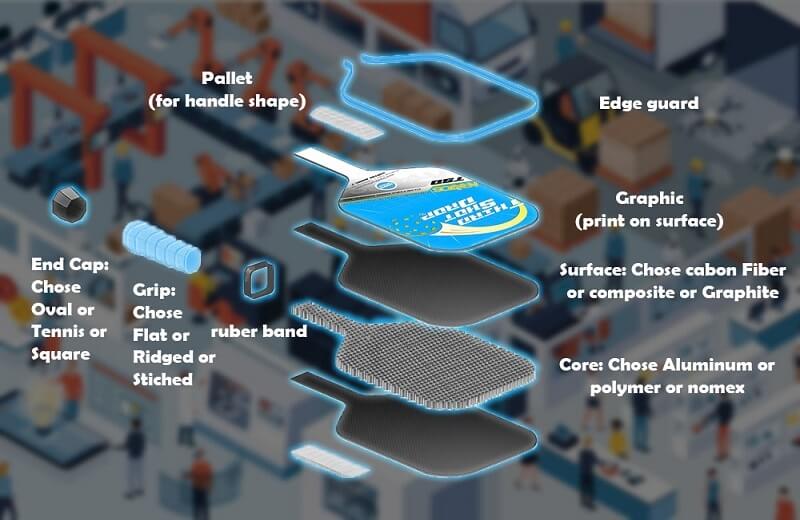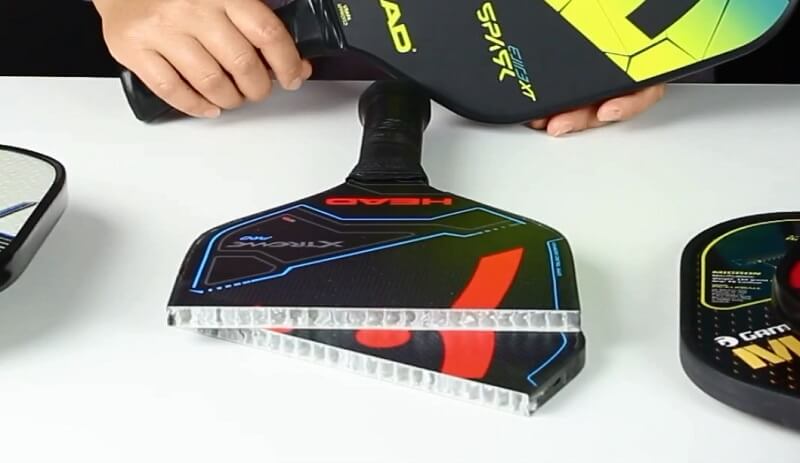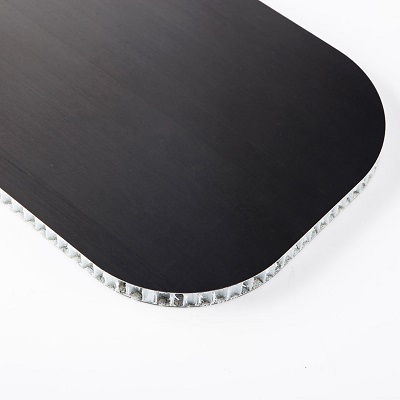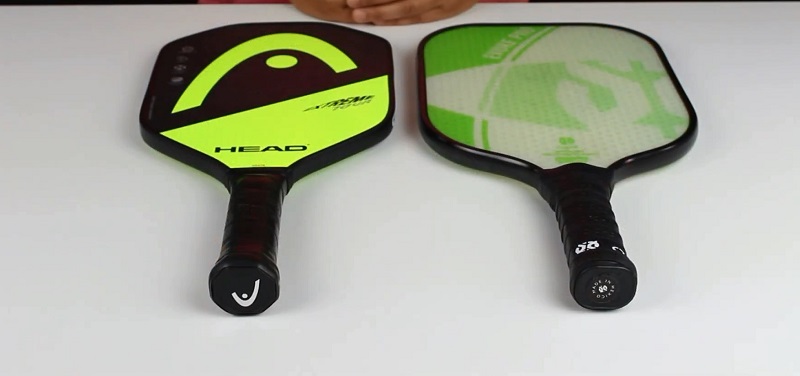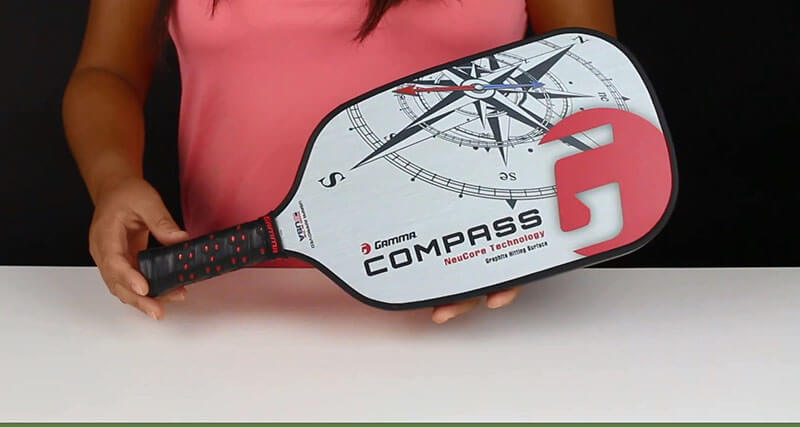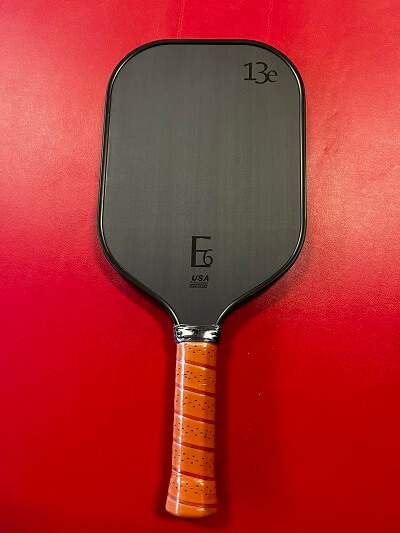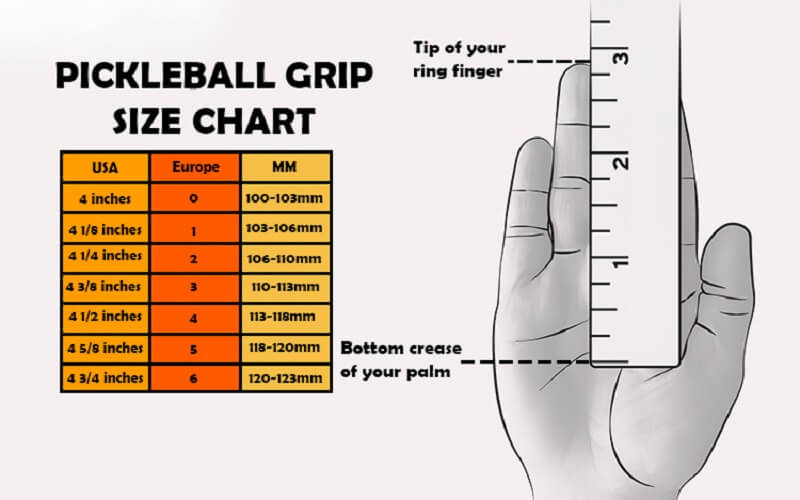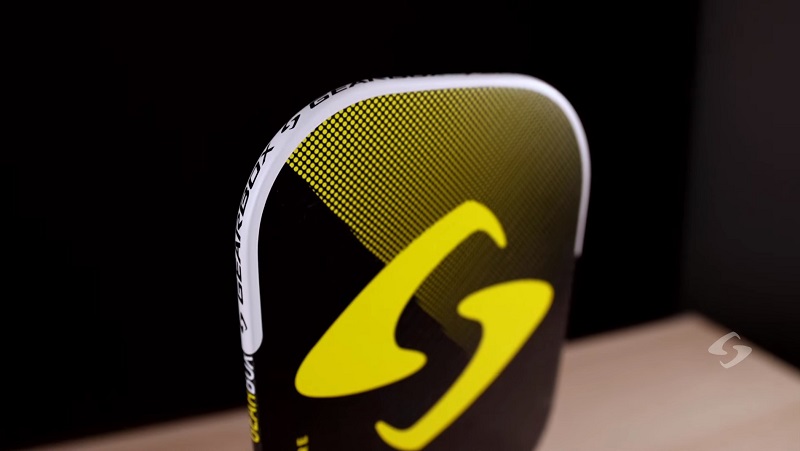5 Factors to Consider While Choosing a paddle
When choosing a pickleball paddle, there are five main factors to consider: core, surface material, shape, weight, and grip size. Each has its unique benefits and drawbacks that can affect your performance on the court.
- Core: The core of a pickleball paddle is what gives it its strength and power while determining how much control you have over your shots.
- Surface material: The surface material of a pickleball paddle is an important factor as it affects the spin and control you have over your shots.
- Shape: The shape of a pickleball paddle is also something to pay attention to when choosing one. The three main shapes are standard, elongated, and longer-handle shapes.
- Weight: The weight of your paddle is also a key factor to consider. Keep in mind that the weight of the paddle should be comfortable for your strength and size.
- Grip size: Finally, grip size is an often-overlooked factor when choosing a pickleball paddle. Make sure to find the right size that fits comfortably in your hand.
By keeping in mind these five factors, you can make ensure you’ve chosen the right pickleball paddle for your playing style and preferences. What makes a pickleball paddle perfect is ultimately up to you! With this guide, you’re now well-equipped to find the way to choose the perfect paddle for your game.
What Are The Effects of Paddle Core on Your Pickleball Gameplay?
The core of the pickleball paddle is arguably the most important factor when choosing a paddle. A good quality core will help to boost spin and control your shots. It also provides cushioning to limit vibration and enhances comfort while playing.
The type of core affects the overall weight of the paddle and how it feels when you’re playing. Pickleball paddles are generally made from either a composite or polypropylene core, but some paddles have an aluminum or graphite core.
Composite and polypropylene cores are lightweight and tend to provide more power, while aluminum and graphite cores are heavier and result in more control.
Wooden paddles are also available, but are not as common, and are usually the least expensive. They provide good power while absorbing some of the shocks from your shots. Aluminum paddles have a larger sweet spot than wooden ones, allowing for more accuracy but less power overall. Graphite is a stiffer material and can provide plenty of power with larger sweet spots.
Effect of Surface Material of Paddles on Pickleball Gameplay
Another important factor to consider is the surface material of a pickleball paddle. Most paddles have either polypropylene, composite, or fiberglass surfaces, but some paddles may be made from plastic or wood.
Polypropylene surfaces are great for beginners because they offer a combination of control and power. On the other hand, fiberglass surfaces tend to be more rigid which provides more spin and better maneuverability.
Composite paddles are usually made from fiberglass or aluminum and offer good power but also allow for more spin on shots. Polymer paddles, on the other hand, provide much more spin due to their softer surface.
Moreover, there’s another material of the paddle which is Nylon. Nylon paddles are lighter in weight than polypropylene, allowing for more power when striking shots and a slightly longer reach on the court. Also, graphite paddles offer the ultimate combination of control and power; they also provide excellent shock absorption, which makes them perfect for experienced players who need to keep their arms and wrists protected.
Types of Shapes of a Paddle Pickleball
Paddles for pickleball are also available in a variety of sizes, shapes, and styles. The size of pickleball paddle, including its length and width, is governed by the game’s rules. For example, a pickleball paddle’s length is limited to 17 inches, but its width and combined length, including the edge guard and cap on the handle, cannot exceed 24 inches. Having stated that there are three typical shapes to think about: standard, elongated, and pickleball paddle with a longer handle shape.
-
Standard Pickleball Paddle Shape
The standard pickleball paddle shape provides balance and stability during play. This is often preferred by beginner players as it gives them more control and accuracy during play.
Pros: The standard pickleball paddle shape is the most common shape of a pickleball paddle. This shape has an even balance between control and power, making it a great choice for beginners who are just starting with pickleball. It also provides players with more surface area for choosing shots, allowing for strategic play.
Cons: The biggest downside to the standard shape is that it does not provide as much power compared to other paddle shapes like the elongated paddle shape. Since the standard pickleball paddle shape is not as aerodynamic as other shapes, it can be more difficult to maneuver in tight spaces. The weight of the paddle also tends to be heavier than others, making it harder for players to react quickly.
- Read more: “TOP 6 Best Pickleball Paddles For Beginners in 2023″
-
Elongated Pickleball Paddle Shape
The elongated pickleball paddle shape has a longer surface area which provides more power and helps increase the reach of your shots. This can be beneficial for advanced pickleball players who need more power in their shots.
Pros: An elongated pickleball paddle shape is great for players who want to maximize their reach. This shape provides a longer handle that gives players more control when they’re away from the net. It also has an aerodynamic design, allowing players to move quickly and react to shots.
Cons: The downside of this shape is that it can be harder for beginner pickleball players to control and can lack accuracy compared to the standard shape. An elongated pickleball paddle shape can be difficult to maneuver in tight spaces. The extra length can also reduce the amount of power behind shots, making it harder to create powerful plays.
-
Pickleball Paddle with a Longer Handle
The pickleball paddle with a longer handle provides more leverage during play, allowing you to put more power behind your shots. This is great for experienced players who need more power during their shots.
Pros: A pickleball paddle with a longer handle provides players with more control when choosing shots away from the net. This type of paddle also helps players reach shots quickly and easily.
Cons: The downside of this shape is that it can be harder to control and lacks accuracy compared to the standard paddle shape. The longer handle can make it difficult to maneuver in tight spaces and the added weight may reduce a player’s reaction time. Additionally, this type of paddle requires more strength from the player to create powerful shots.
How Does Pickleball Paddle Weight Affect Your Pickleball Gameplay?
The weight of a pickleball paddle is an important consideration for any player. An ideal pickleball paddle should feel comfortable and balanced in your hand, otherwise, it can affect your control of the ball and accuracy when serving or returning shots. The average pickleball paddle weighs between 7-9 ounces, although some paddles can be as light as 6 ounces or as heavy as 11 ounces.
Generally, a lighter paddle will give you more maneuverability, a better spin, and more power when smacking the ball; however, choosing a heavier paddle can help with the accuracy and control of your shots and offers increased stability and power. So, it is important to find the weight that works best for your style of playing before choosing a pickleball paddle.
Pickleball Paddle Grip
Another important consideration when selecting a pickleball paddle is the grip size. The grip size is measured from the bottom of the handle to where your fingers would wrap around it. Grip sizes range from 4-5 inches, and choosing the right one for your hand can make all the difference in your game.
A grip size that is too small can be uncomfortable and cause hand fatigue, while a grip size that is too large can be awkward to hold, resulting in poor control of the paddle. Moreover, smaller grips offer more control but limit the amount of power you can generate from each shot, while larger grips offer more power with less precision.
Ultimately, choosing the right pickleball paddle comes down to personal preference. Consider your playing style and level of experience when choosing a paddle that best suits you. Understanding the different types of cores and surface materials available can help you make an informed decision when picking a pickleball paddle. So, now you know what to look for in a pickleball paddle.
How to Find Your Paddle Grip Size?
The size of the grip on your pickleball paddle is an important factor to consider when choosing a paddle. Grip sizes can range from 4 1/4’’ to 5 1/2’’ in diameter. This means that you will need to measure your hand to find out what size works best for you.
To determine your grip size, measure the circumference (the distance around) of your dominant hand in inches. You can do this by wrapping a measuring tape around your hand just below the knuckles and fingers. Once you have determined the circumference of your hand, round up to the nearest 1/4’’ increment. For example, if you measure 4 1/2’’, your grip size would be 4 3/4’’.
Once you have your grip size, the next step is to choose a paddle that has the correct circumference. Most pickleball paddles come with an adjustable or customizable handle so that you can adjust it to fit your hand size.
A properly sized grip will help to ensure optimal control and power when playing pickleball and choosing a paddle that is suited for your grip size is an important step in choosing the right paddle.
Edge Guard VS Edgeless Paddles
Edge guard and edgeless pickleball paddles are two of the most popular paddle styles in the market today. Edge guard paddles have plastic wrapped around their perimeter, which helps protect them from scratches or dings that could occur during regular play.
They can help protect your paddle while playing, especially if you accidentally clip another player’s paddle. However, they may add some weight and take away from power and control due to friction.
On the other hand, edgeless paddles have no extra plastic wrapping and can be more impactful when it comes to ball control. Edgeless paddles do not have edge guards and give you more power, control, and maneuverability.
Ultimately, choosing between an edge guard and an edgeless paddle depends on the type of player you are – if you’re a beginner looking for increased ball control, then an edgeless paddle may be worth considering, while if you need extra protection from normal wear and tear, then an edge guard paddle could be the right option for you.
Other Considerations for Pickleball Paddles
When choosing a pickleball paddle, there are some additional factors to consider that can make all the difference when choosing the right one. Here are some of the things to think about when selecting your new pickleball paddle:
- USA Pickleball Approved: One of the most important considerations is whether your paddle is USA Pickleball Approved or not. This certification ensures that all paddles adhere to certain standards set by USAPA (USA Pickleball Association). It is recommended that you look for a paddle that is USA Pickleball Approved, as this will ensure you are getting a product of the highest quality.
- Thickness: The next consideration when choosing a pickleball paddle is its thickness. A thicker paddle will offer more power and stability than a thinner one, while also providing more control over shots. However, it can be difficult to maneuver a thicker paddle and it may be too heavy for some players. Therefore, it is important to choose a thickness that suits your playing style and abilities.
- Edge Guard: Finally, choosing the right edge guard on your pickleball paddle is also important. Edge guards provide extra protection against wear and tear and help you maintain control over shots. They should fit securely on the paddle, but they should not be too tight or too loose.
FAQs
Where to Buy a Pickleball Paddle?
What makes a Good Pickleball Paddle?
How Long Does a Pickleball Paddle Last?
What Pickleball Paddle Do Most Pros Use?
What is the Lightest Pickleball Paddle?
Bottom Line
Thinking about how to pick a pickleball paddle? It may not seem like an easy task, but now that you know the five main factors to consider when choosing one, you can confidently select a paddle that is perfect for your playing style.
Be sure to keep in mind the different types of cores, surface materials, shapes, weights, and grip sizes when making your purchase so you end up with a paddle that best fits your playing style and find one that meets all of your needs. With this guide in hand, you will have all the information needed to make an informed decision and buy a pickleball paddle that optimizes your gameplay. The choice is up to you!
Related Articles:
- Pickleball court Dimensions: Official Size & DIY Court Setup
- 8 Easy Ways To Find Pickleball Courts Near Me 2023
- Want to Know How to Play Pickleball? It’s Easier Than You Think
- Difference Between Indoor and Outdoor Pickleball
- Pickleball Sayings: Definitions To Get Familiar with Pickleball
- Onix Z5 Graphite & Composite Pickleball Paddle Review 2023
- TOP 10 Best Pickleball Paddle Brands 2023 [Pro Sponsor Brand]

